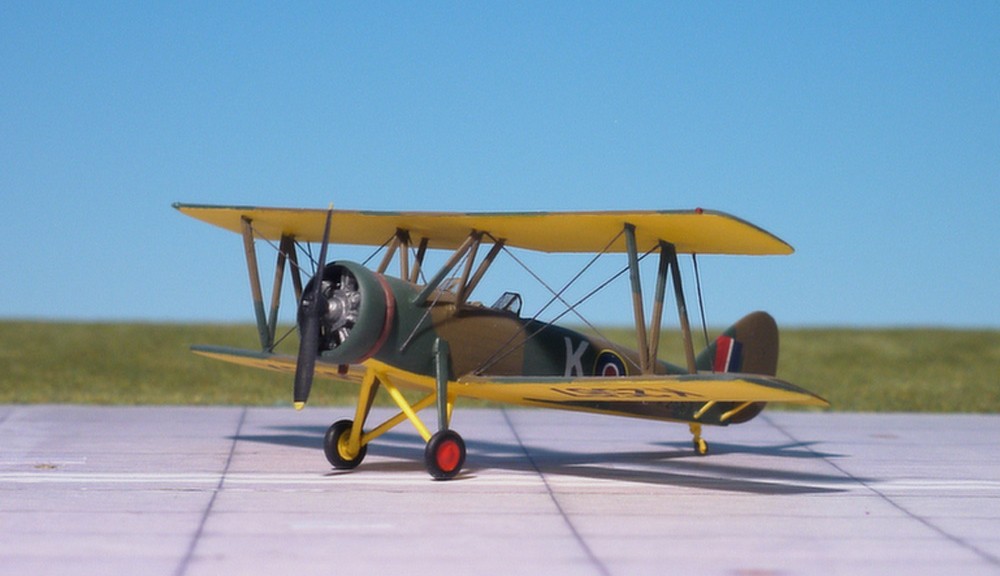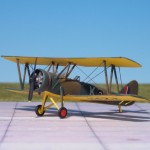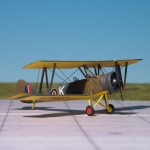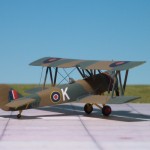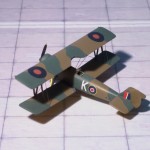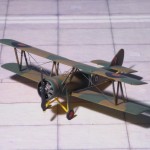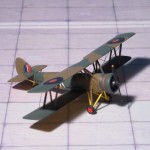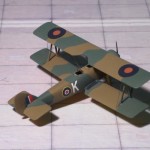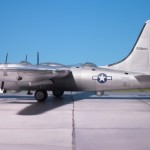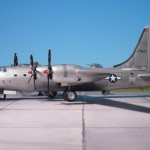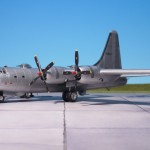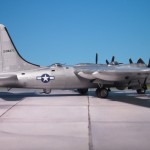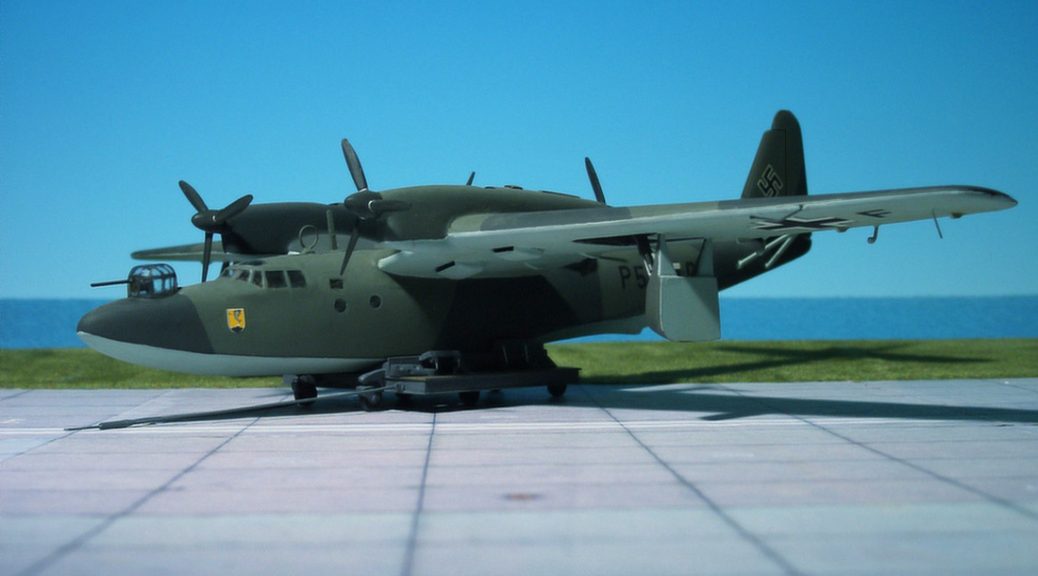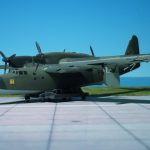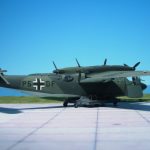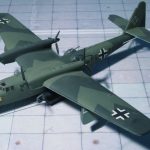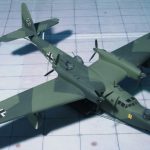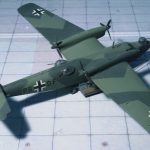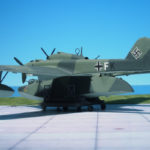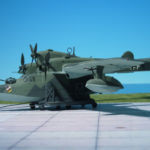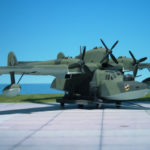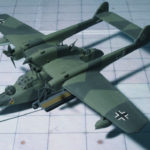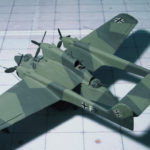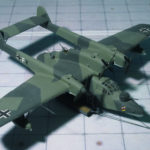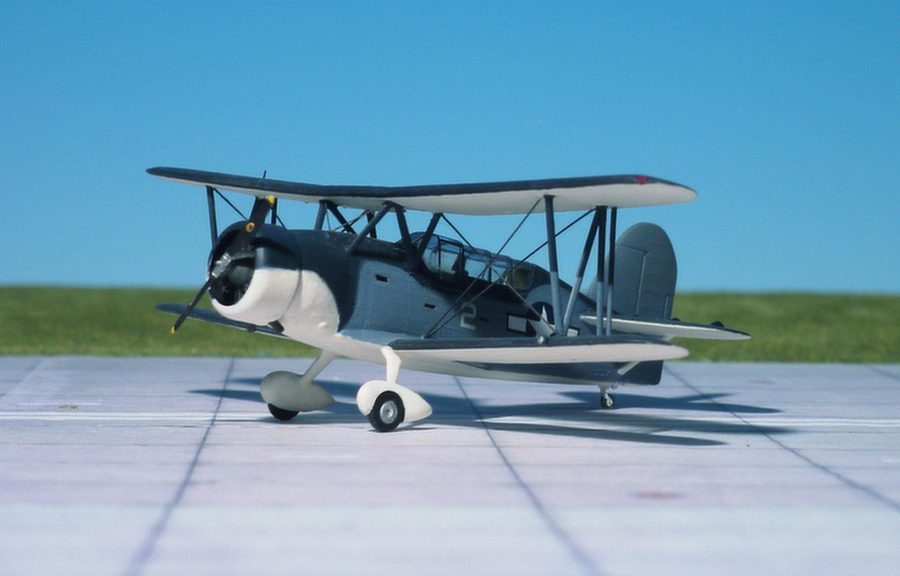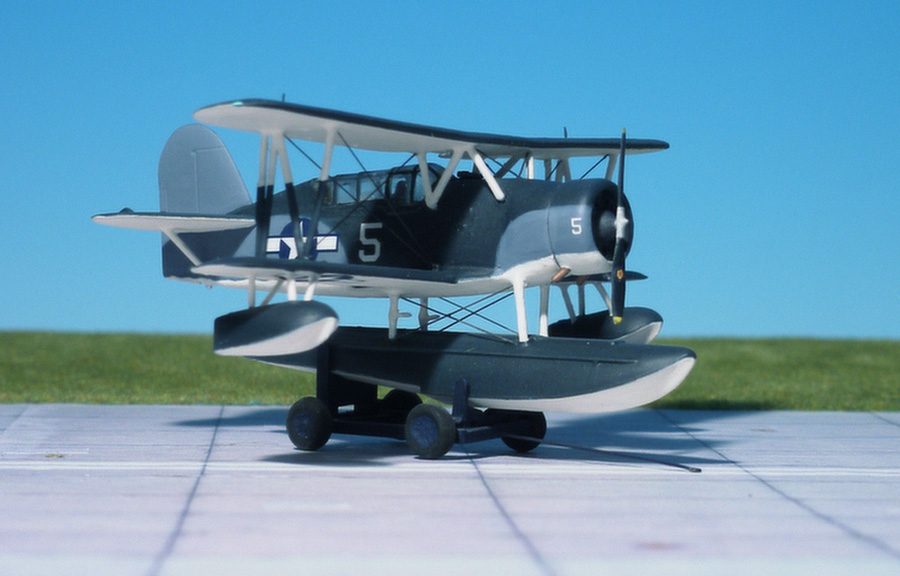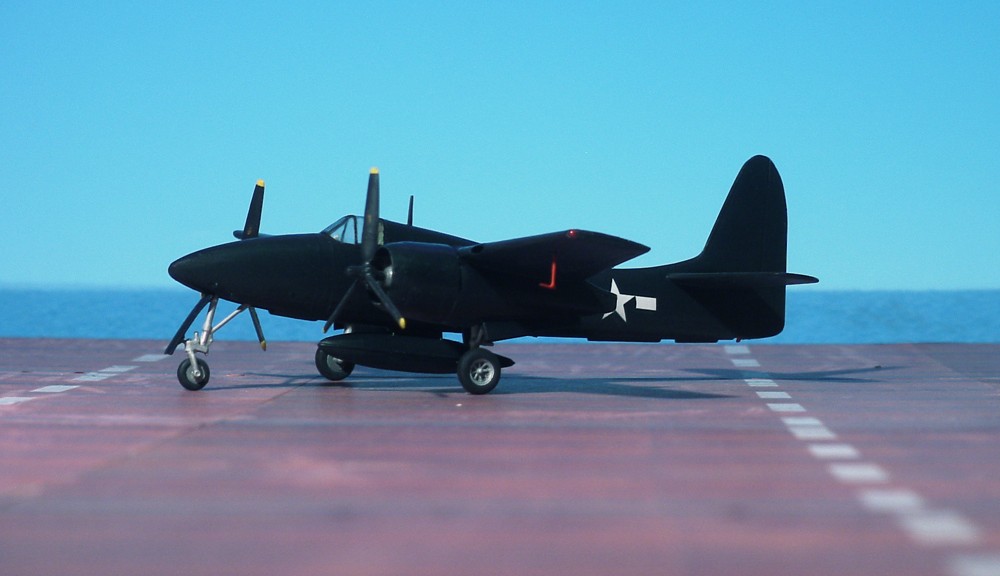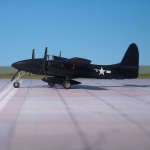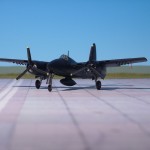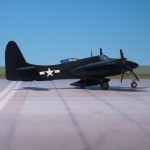Monthly Archives: August 2014
Consolidated B-32 “Dominator” (Anigrand, Resin)
TYPE: Heavy bomber
ACCOMMODATION: Crew of ten
POWER PLANT: Four Wright R-3350-23A radial engines, rated at 2,200 hp each
PERFORMANCE: 357 mph at 30,000 ft
COMMENT: The Consolidated B-32 “Dominator” was a heavy bomber made for the USAAF during WWII, and had the distinction of being the last Allied aircraft to be engaged in combat during World War II. It was developed in parallel with the Boeing B-29 “Superfortress” as a fallback design should the B-29 prove unsuccessful. The design on which Consolidated based its proposal was similar to the Consolidated B-24 “Liberator”. Like the B-24 it was originally designed with twin fins and a large Davis-type wing, but with a longer, rounder fuselage and a rounded nose. The aircraft was designed to be pressurized, and have remote-controlled retractable gun turrets with fourteen .50 in machine guns. The turrets were remotely controlled from periscopic sights in aiming stations inside the aircraft. The sights were coordinated by a sophisticated analog computer system. The inboard propellers’ pitch could be reversed to shorten the landing roll or to roll back in ground maneuvers. The first prototype made its maiden flight on 7 September 1942. In 1943, the initial contract was signed for 300 B-32 but development problems continued. In order to resolve stability problems a B-29 style tail was fitted to the aircraft after its 25th flight. But this did not resolve the problem and a Consolidated-designed 19.5 ft vertical tail was added and first flown on the third XB-32 on 3 November 1943. By 1944 testing of the three prototypes permitted the USAAF to place orders for over 1,500 B-32s. The first production aircraft was delivered on 19 September 1944, by which time the B-29 was in full combat in the Pacific Area of Action. Beginning on 27 January 1945, 40 B-32A-5, -10 and -15 aircraft were delivered as unarmed TB-32-CF crew trainers. The B-32 only reached units in the Pacific Area during mid-1945, and subsequently only saw limited combat operations against Japanese homeland before the end of the war. Most of the extant orders of the B-32 were cancelled shortly thereafter and only 118 B-32 airframes of all types were built (Ref.: 23).
Dornier Do 26D-0 (Airmodel, Vacu)
TYPE: Transport and reconnaissance flying boat
ACCOMMODATION: Crew of four
POWER PLANT: Four Junkers Jumo 205D liquid-cooled, opposed-piston diesel engine, rated at 880 hp each
PERFORMANCE: 208 mph
COMMENT: The elegant Dornier Do 26, sometimes referred to as the “most beautiful flying-boat ever built”, was of all-metal construction. Originally designed as a civilian transport aircraft for the “Deutsche Lufthansa”, the few aircraft built before and immediately at the beginning of WW II were pressed into military service at the outbreak of the war in Europe.
The hull had a central keel and a defined step; the wings were of gull wing configuration, the outer sections being equipped with fully retractable narrow stabilizing wing-floats, instead of Dornier’s famous “water-wing” sponsons extending from the lower hull for lateral stabilization.
Its four Junkers Jumo 205 diesel engine, were mounted in tractor/pusher pairs in tandem nacelles located at the joint between the dihedral and horizontal wing sections. The rear (pusher) engines could be swung upwards through 10° during take-off and landing, to prevent contact between the three-blade airscrew and water spray created by the forward propellers. The tail unit was of conventional design, comprising a horizontal tail-plane and a single, vertical fin with rudder. Armament consisted of one 20 mm MG 151/20 cannon in a power-operated bow turret and three 7.92 mm MG 15 machine guns.
Only six aircraft were built and put into Luftwaffe service. They were used in the Norwegian campaign for transporting supplies, troops and wounded to and from the isolated German forces fighting at Narvik. During this campaign three of them were lost. Another Dornier Do 24C was lost on 16 November 1940, killing its crew, after being launched at night from the catapult ship “Friesenland” in Brest, France. The fate of two remaining aircraft, which in 1944 were still assigned to the “Erprobungsstelle” (Test Unit) in Travemünde, Germany, is unclear (Ref.: 24).
Blohm & Voss Bv 138C-1 (“Seedrache”, „Sea Dragon“), Supermodel
TYPE: Long-range maritime reconnaissance flying boat
ACCOMMODATION: Crew of six
POWER PLANT: Three Junkers Jumo 205D liquid-cooled, vertically opposed diesel engine, rated at 870 hp each
PERFORMANCE: 177 mph at 19,700 ft
COMMENT: Originally developed under the company name of Hamburger Flugzeugbau, the type was initially designated the Ha 138. Its appearance was unique in its combination of unusual design features with its twin boom tail unit, short fuselage and trimotor engine configuration. The short hull, with its hydrodynamic step beneath and flat sides, earned it the nickname “Der fliegende Holzschuh” (“The flying clog”).
Three piston engines were used. The central engine was mounted above the wing, driving a four-blade propeller, while the wing engines were lower, with three-blade propellers. The pre-production prototypes were powered by various makes of engines ranging from 650–1,000 hp. The first standardized version, BV 138B-1, was powered by three 868 hp Junkers Jumo 250D two-stroke, opposed-piston aircraft diesel engines. The engine cowlings also had an atypical appearance, due to the unique nature of the vertical orientation of the six-cylinder opposed-piston Jumo 205 diesel engines, and resembled the cowlings of 4 or 6-cylinder inverted inline engines found on smaller civil and utility aircraft from the Jumo 205’s propshaft placement, emerging forward at the uppermost front end of the power plant.
The booms of the twin tail unit, much like the smaller Focke-Wulf Fw 189 twin-engine reconnaissance monoplane, extended horizontally from the rear of the outer engine nacelles.
For hydrodynamic reasons, the hull featured a distinct “turn-down”, or “beak” at the stern. Two enclosed, powered gun turrets, each mounting a single MG 151/20 autocannon, were located prominently at the bow and stern. A third, fully open Scarf ring-like emplacement, behind the central engine and both above and forward of the rear turret, mounted a MG 131 heavy machine gun covered fields of fire obstructed from the other turrets by the horizontal stabilizer.
In all, 227 examples of standard service variants of the BV 138 were built. The first such variant, Bv 138C-1, began service in March 1941. While non-standard variants carried a variety of armament, the standard variant featured two 20 mm MG 151/20 cannons, one in a power-operated bow turret and one in a power-operated stern turret, up to three 7.92 mm MG 15 machine guns, and a 13 mm MG 131 machine gun in the aft center engine nacelle. It could carry up to 500 kg of bombs or depth charges (under the starboard wing root only) or, in place of these, up to 10 passengers. Both the B-1/U1 and C-1/U1 variants had racks under both wings to double the offensive load.
Some examples of the BV 138 were adapted to specialized roles. The Bv 138 was tested with the oft-used Walter HWK 109-500 “Starthilfe” (RATO) jettisonable rocket pod, used in pairs, for shorter take-off performance. One anti-shipping variant carried FuG 200 “Hohentwiel” low-UHF band maritime search radar. The BV 138 MS variant was converted for minesweeping (suffix “MS” means “Minen-Suchgerät”, “mine-search” aircraft, and carried magnetic field-generating degaussing equipment, including a hoop antenna with a diameter equal to the length of the fuselage, which encircled the hull and wings, which was also used on certain models of the Junkers Ju 52/3m trimotor transport used for the same duty (Ref. 24).
Curtiss SOC-2 “Seagull” (Hasegawa)
TYPE: Scout observation airplane, trainer
ACCOMMODATION: Pilot and observer
POWER PLANT: One Pratt & Whitney R-1340-18 radial engine, rated at 550 hp
PERFORMANCE: 165 mph at 5,000 ft
COMMENT: The Curtiss SOC “Seagull” was an American single-engine scout observation biplane aircraft, designed by the Curtiss-Wright Corporation for the US Navy. The aircraft served on battleships and cruisers in a seaplane configuration, being launched by catapult and recovered from a sea landing. The wings folded back against the fuselage for storage aboard ship. When delivered from factory or based ashore or on carriers the single float was replaced by fixed wheeled landing gear.
The SOC was ordered for production by the US Navy in 1933 and first entered service in 1935. The first order was for 135 SOC-1 models, which was followed by 40 SOC-2 models for landing operations and 83 SOC-3s. A variant of the SOC-3 was built by the Naval Aircraft Factory and was known as the SON-1
The SOC was not called the “Seagull” until 1941, when the U.S. Navy began the wholesale adoption of popular names for aircraft in addition to their alpha-numeric designations (Ref.:24).
Curtiss SOC-3 “Seagull” (Hasegawa)
TYPE: Scout observation float-plane, trainer
ACCOMMODATION: Pilot and observer
POWER PLANT: One Pratt & Whitney R-1340-18 radial engine, rated at 550 hp
PERFORMANCE: 165 mph at 5,000 ft
COMMENT: The Curtiss SOC “Seagull” was an American single-engine scout observation biplane aircraft, designed by the Curtiss-Wright Corporation for the US Navy. The aircraft served on battleships and cruisers in a seaplane configuration, being launched by catapult and recovered from a sea landing. The wings folded back against the fuselage for storage aboard ship. When based ashore or on carriers the single float was replaced by fixed wheeled landing gear.
The SOC was ordered for production by the US Navy in 1933 and first entered service in 1935. The first order was for 135 SOC-1 models, which was followed by 40 SOC-2 models for landing operations and 83 SOC-3s. A variant of the SOC-3 was built by the Naval Aircraft Factory and was known as the SON-1
By 1941, most battleships had transitioned to the Vought OS2U “Kingfisher” and cruisers were expected to replace their aging SOCs with the third generation Curtiss SO3C “Seamew”. The SO3C, however, suffered from a weak engine and plans to adopt it as a replacement were scrapped. The SOC, despite belonging to an earlier generation, went on to execute its missions of gunfire observation and limited range scouting missions.
The SOC was not called the “Seagull” until 1941, when the U.S. Navy began the wholesale adoption of popular names for aircraft in addition to their alpha-numeric designations.
When operating as a seaplane, returning SOCs would land on the relatively smooth ocean surface created on the sheltered side of the vessel as it made a wide turn, after which the aircraft would be winched back onto the deck.
When the SOC was replaced by the OS2U “Kingfisher”, most remaining airframes were converted into trainers; they remained in use until 1945. With the failure of the Curtiss SO3C “Seamew”, many SOCs in second line service were returned to frontline units starting in late 1943. They saw service aboard warships in the combat zone for the rest of World War II. This is one of the few instances in aviation history in which an older aircraft type, that was retired or sent to second line service, replaced the new aircraft type that was intended to replace it (Ref.: 24).
Grumman F7F-1 Tigercat (Monogram)
TYPE: Carrier-based fighter-bomber
ACCOMMODATION: Pilot only
POWER PLANT: Two Pratt & Whitney R-2800-22W Double Wasp engines, rated at 2,100 hp each
PERFORMANCE: 427 mph at 19,200 ft
COMMENT: In mid 1938, the US Navy had ordered a prototype twin-engine fighter from the Grumman Company and, by middle of 1941, preliminary flight-test data for this aircraft, the XF5F-1 (Grumman G-45) was available. Although the XF5F-1 suffered a number of shortcomings, it provided a useful basis for the development of a larger twin-engine fighter. Ordered in June 1941 and designated XF7F-1 this new fighter was intended to be operated from the forthcoming 45,000 ton carriers of the USS Midway class. It was the Navy’s first twin built in production quantities, and the first carrier-based fighter to operate with a tricycle undercarriage. Although classified as a fighter the aircraft was designed to operate in a ground-support role, for which it was heavily armed. In early 1944 an order for 500 Tigercats was given and deliveries began in April 1944. Operational problems and changing requirement let to restriction in the production program. After 34 F7F-1 had been delivered production switched to 189 F7F-3s, similar to the single-seat model but with more powerful R-2800-34W engines. Including two-seated night-fighter variants , the Grumman F7F-3N Tigercat, production totaled 250 aircraft. Too late for operational service in WW II, the Tigercat served with a few Marine squadrons after the war but was soon displaced by the advent of jet-powered aircraft. (Ref. 18)
Ryan F2R-1 Dark Shark (MPM)
TYPE: Carrier-borne fighter
ACCOMMODATION: Pilot only
POWER PLANT: General Electric XT31-GE-2 turboprop and General Electric J31-GE-3 turbojet
PERFORMANE: 497 mph at sea level
COMMENT: The Ryan XF2R Dark Shark was an American experimental aircraft built for the United States Navy that combined turboprop andturbojet propulsion. It was based on Ryan Aeronautical’s earlier FR Fireball, but replaced the Fireball’s piston engine with a turboprop engine.
The XF2R Dark Shark was based on Ryan Aeronauticl’s earlier FR Fireball, but replaced the Fireball’s piston engine with a General Electric T31 turboprop engine driving a 4-bladed Hamilton Standard propeller. The turboprop made for much improved performance over the Fireball, but the Navy showed little interest in it; by that time, they had abandoned the idea of the combination fighter and were instead looking into all-jet fighters.
The United States Air Force, however, showed a little more interest; they were at the time evaluating the Convair XP-81 of similar concept, and asked Ryan to modify the XF2R to use the Westinghouse J34 turbojet instead of the General Electric J31 used previously. Modifications to theprototype created the XF2R-2, with the jet intakes moved to the sides of the forward fuselage with NACA ducts instead of the inlets in the wing leading edge used before.
Although the Dark Shark proved to be a capable aircraft, it never got further than the prototype stage; all-jet aircraft were considered superior (Ref.: 24).
